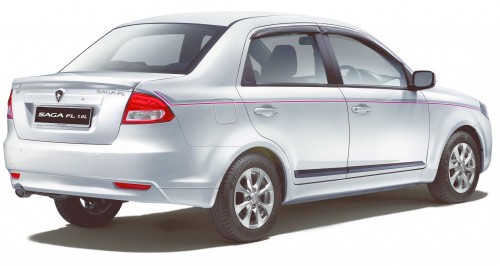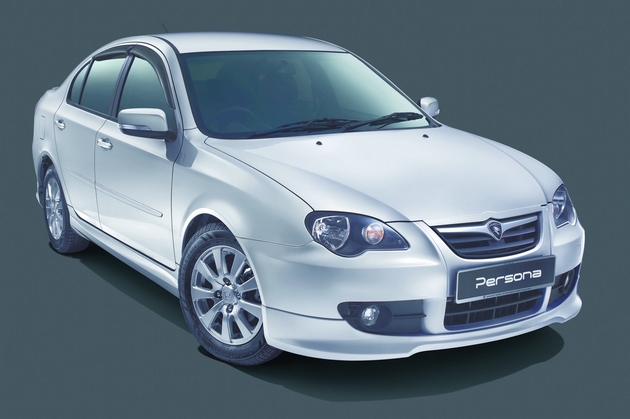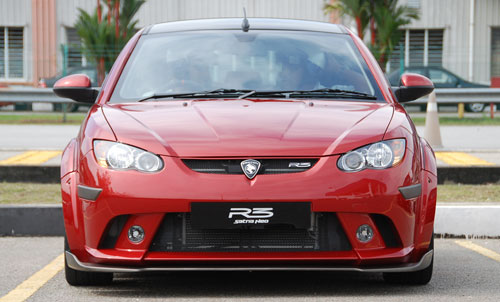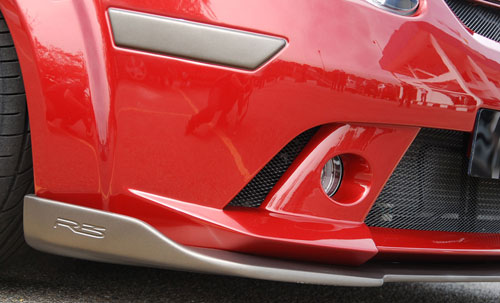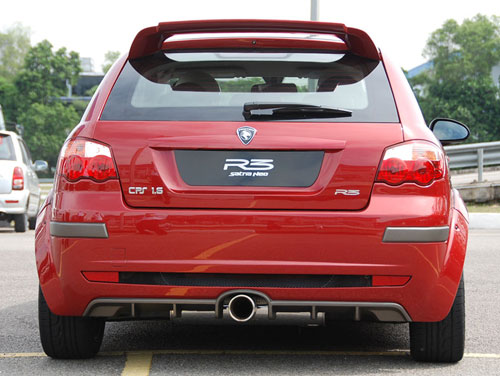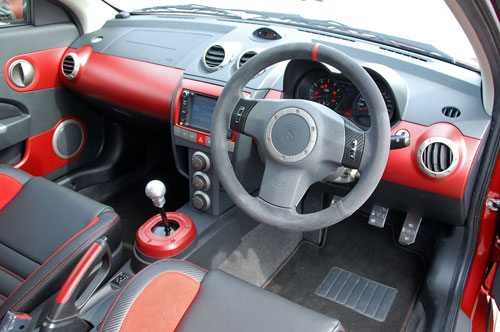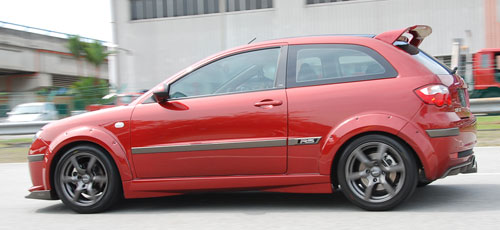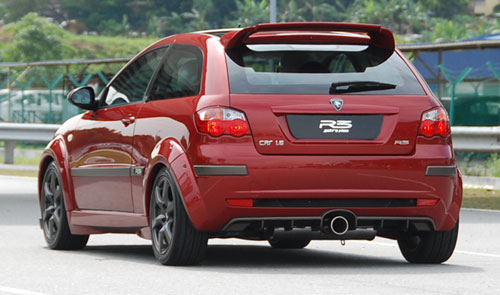We are back from a short test drive session of the Proton R3 Satria Neo, which happened at Proton’s testing ground in Shah Alam. Unlike the RM115k limited edition Lotus Racing Satria Neo (back when Proton and 1MRT were still on friendly terms), this version is much more accessible at RM79,797 but will still provide enthusiastic drivers with plenty of smiles.
To keep the price down, the R3 Neo doesn’t include the Lotus Racing Neo’s headline Ohlins suspension and AP Racing brakes, which were inspired by the real Lotus cars. The modded Campro CPS engine is the same. As we found out, the changes don’t detract from the fun factor and performance of the LR Neo, which makes it the better buy. There are even some improvements thrown in.
Continue reading the report after the jump.
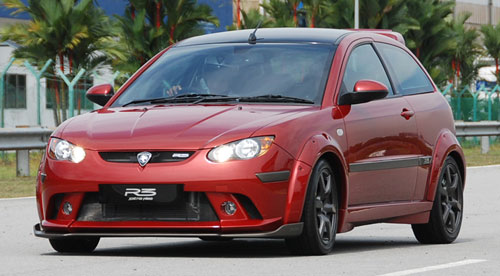
This R3 Neo isn’t an afterthought or a development of the Lotus Racing Neo, although that limited edition came out first. On the contrary, development of this car started three months before the LR Neo was launched, which translates to early 2010, explains Tengku Djan, head of R3. After that, the idea of a Lotus Racing Neo came along, and R3 had to rush that car out within 6-7 weeks.
So we are actually looking at the final fruit of R3′s tweaking of the Satria Neo. In a nutshell, the R3 Neo is powered by the exact same engine as the LR Neo, which is the Campro CPS unit upgraded to make 145 hp at 7,000 rpm and 168 Nm of torque at 5,000 rpm. The stock engine makes 125 hp and 150 Nm. No Ohlins coilovers and mega AP brakes here; this car comes with R3 specified suspension and stoppers.
The S4PH powerplant has been given a host of upgrades to reach this state. Reprofiled camshafts that increase valve lift and overlap helps breathing, aided by a K&N filter in a carbon air box. Lightweight adjustable camshaft pulleys reduce inertia and enable fine tuning of valve timing.
To match all these is an R3 ECU calibrated with revised fuel maps and a focus on performance. There’s also a 4-2-1 R3 exhaust system similar in design to that found in the LR Neo, except that it’s in full stainless steel and without silicone coating. Mated to the engine is a close ratio five-speed manual gearbox – there’s no auto option. 0-100 km/h is done in 9.2 seconds, top speed is 205 km/h.
For the suspension, R3 ordered a few settings from the OE manufacturer before finally deciding on this set. The springs are shorter and their rates firmer than the standard Neo CPS. As for what they were looking to achieve for the handling, drift master Tengku Djan said that R3 wanted to “bring back a bit of the old GTI feel”, referring to the old body Satria GTI and Satria R3. Ride height is 10 mm lower than the Neo CPS.
Brakes wise, the R3 Neo uses performance pads that have an operating temperature of up to 400 degrees C and increased fade resistance over the standard car. The calipers are stock.
The Satria Neo is already one of the most sporty three-door hatchback designs around, and the R3 Neo takes it a step further. Only available in “Fire Red” with a black roof and bronze accents, it looks fantastic in the sunlight. Not sure about you, but I never really liked the LR’s green and yellow theme – this looks much better in my opinion. Also nice are those six-spoke 16-inch R3 alloys in gunmetal.
Unlike the LR edition, the R3 Neo uses the standard Neo CPS bodywork, with additions such as a front splitter (reduces undercarriage turbulence and increases downforce, according to R3) and a new design spoiler, which is more subtle than the standard car’s and improves aerodynamics. There are R3 logos on the sides of the wing. The rear bumper is stock, although the trademark central exhaust tip is different.
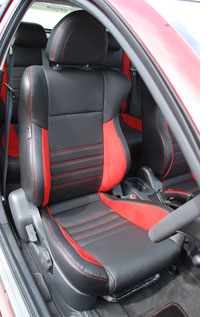 I stepped in the car expecting the typical Neo reception of zero headroom (I’m not that tall at 175 cm, but we’re required to wear helmets when driving at Proton’s oval) and looking through the top quarter of the windscreen, but was pleasantly surprised to find that there was room to spare.
I stepped in the car expecting the typical Neo reception of zero headroom (I’m not that tall at 175 cm, but we’re required to wear helmets when driving at Proton’s oval) and looking through the top quarter of the windscreen, but was pleasantly surprised to find that there was room to spare.I was then told that the seats are new – the rails are in the same place, but the seat base goes deeper now to free up some much needed headroom. You’ll also notice that the seat backs are more shapely compared to the old chairs – there’s added thigh, hip and shoulder support here.
The steering wheel is wrapped in “Trivel Fibre”, which is an Alcantara type material, and has a red centre marker, just like in Renault Sport cars. The panels around the audio buttons have the carbon fibre look. There are lots of panels in red to match the exterior and like in the LR Neo, the gear knob is a chromed ball. The aluminium pedals are identical as well.
 We weren’t given much time behind the wheel, but enough for a good impression. Flex your right foot and the louder exhaust note is immediately noticeable. The R3 Neo pulls away cleanly and smoothly, without being bogged down by any holes and trenches in the torque delivery. But it’s not particularly strong below 4,000 rpm, which is the point the high lift cam profile comes into play.
We weren’t given much time behind the wheel, but enough for a good impression. Flex your right foot and the louder exhaust note is immediately noticeable. The R3 Neo pulls away cleanly and smoothly, without being bogged down by any holes and trenches in the torque delivery. But it’s not particularly strong below 4,000 rpm, which is the point the high lift cam profile comes into play.As expected, from here, the engine gains a second wind as it charges towards redline, which is 7,500 rpm in the R3 Neo (cut off at 7,800), although the unchanged meter panel will show that you’re already swimming deep in the red sea. Once in the zone, the tacho needle gains urgency that’s previously unseen, and there’s no slowing down because the Variable Intake Manifold (VIM) changes to the short runner at 5,500 rpm.
The R3 Neo, like the standard car, is meant to be revved all out for enjoyment, and with the short ratio gearbox, it’s extremely effortless to get there – it’s time for the next gear before you know it. The sound is more towards boomy than VTEC screamy, but it’s fun nevertheless.
We also tried out the R3 Neo over a section of crests and dips to check out the primary ride, which it passed with admirable composure. Rolling over thin metal strips saw the Neo cushion away the impact instead of reacting with a bounce or shimmy. We’ll never know how it feels like on a poorly surfaced B-road with these examples, but I’m betting it’ll cope well.
Doing the slaloms at 70 km/h revealed a slightly different character from our limited Lotus Racing Neo experience (never got to drive it on public roads). While the green car gave hints that it likes to dance around the cones, rear end edging out a little, the R3 Neo felt less active at the back. More like a normal road car, in other words, albeit a grippy one that corners very flat. Turn in is sharp, and steering feel is good. Can’t wait to drive it on the road.
We did some braking tests as well, and while this car doesn’t have the stupendous stopping power of the LR Neo’s AP Racing brakes, it’s more than good enough, and there wasn’t any fade although I wasn’t the first to do the test. The LR edition is probably the most over braked car in the world, so we’re just reverting to the real world – no big loss.
The R3 Satria Neo serves up good looks and good vibes for the enthusiast driver. It’s quite good value too – 80k for 145 hp can’t be found elsewhere (correct us if we’re wrong, new cars only) – and has new features that the wider market appreciates such as a push start button and a 2-DIN touch screen ICE system with GPS.
It’s not perfect though – just as I was getting tempted, the Neo’s long and heavy free swinging door slammed on my hips upon exit, not for the first time.
Article sources : Paultan



